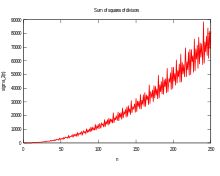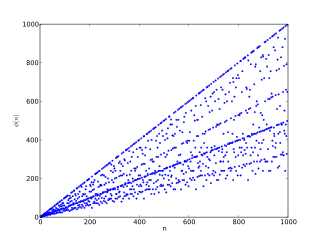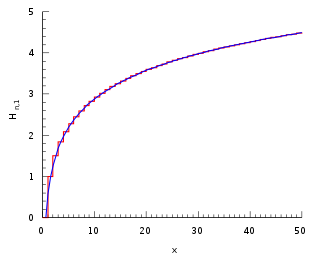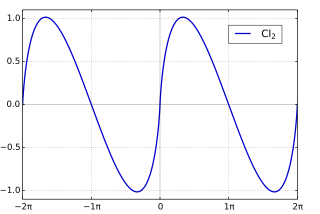For a prime number p,

because by definition, the factors of a prime number are 1 and itself. Also, where pn# denotes the primorial,

since n prime factors allow a sequence of binary selection ( or 1) from n terms for each proper divisor formed. However, these are not in general the smallest numbers whose number of divisors is a power of two; instead, the smallest such number may be obtained by multiplying together the first n Fermi–Dirac primes, prime powers whose exponent is a power of two. [4]
or 1) from n terms for each proper divisor formed. However, these are not in general the smallest numbers whose number of divisors is a power of two; instead, the smallest such number may be obtained by multiplying together the first n Fermi–Dirac primes, prime powers whose exponent is a power of two. [4]
Clearly,  for all
for all  , and
, and  for all
for all  ,
,  .
.
The divisor function is multiplicative (since each divisor c of the product mn with  distinctively correspond to a divisor a of m and a divisor b of n), but not completely multiplicative:
distinctively correspond to a divisor a of m and a divisor b of n), but not completely multiplicative:

The consequence of this is that, if we write

where r = ω(n) is the number of distinct prime factors of n, pi is the ith prime factor, and ai is the maximum power of pi by which n is divisible, then we have:

which, when x ≠ 0, is equivalent to the useful formula:

When x = 0,  is:
is:

This result can be directly deduced from the fact that all divisors of  are uniquely determined by the distinct tuples
are uniquely determined by the distinct tuples  of integers with
of integers with  (i.e.
(i.e.  independent choices for each
independent choices for each  ).
).
For example, if n is 24, there are two prime factors (p1 is 2; p2 is 3); noting that 24 is the product of 23×31, a1 is 3 and a2 is 1. Thus we can calculate  as so:
as so:

The eight divisors counted by this formula are 1, 2, 4, 8, 3, 6, 12, and 24.
Other properties and identities
Euler proved the remarkable recurrence: [6] [7] [8]

where  if it occurs and
if it occurs and  for
for  , and
, and  are consecutive pairs of generalized pentagonal numbers ( OEIS: A001318 , starting at offset 1). Indeed, Euler proved this by logarithmic differentiation of the identity in his pentagonal number theorem.
are consecutive pairs of generalized pentagonal numbers ( OEIS: A001318 , starting at offset 1). Indeed, Euler proved this by logarithmic differentiation of the identity in his pentagonal number theorem.
For a non-square integer, n, every divisor, d, of n is paired with divisor n/d of n and  is even; for a square integer, one divisor (namely
is even; for a square integer, one divisor (namely  ) is not paired with a distinct divisor and
) is not paired with a distinct divisor and  is odd. Similarly, the number
is odd. Similarly, the number  is odd if and only if n is a square or twice a square.
is odd if and only if n is a square or twice a square.
We also note s(n) = σ(n) − n. Here s(n) denotes the sum of the proper divisors of n, that is, the divisors of n excluding n itself. This function is used to recognize perfect numbers, which are the n such that s(n) = n. If s(n) > n, then n is an abundant number, and if s(n) < n, then n is a deficient number.
If n is a power of 2,  , then
, then  and
and  , which makes n almost-perfect.
, which makes n almost-perfect.
As an example, for two primes  , let
, let
 .
.
Then


and


where  is Euler's totient function.
is Euler's totient function.
Then, the roots of

express p and q in terms of σ(n) and φ(n) only, requiring no knowledge of n or  , as
, as


Also, knowing n and either  or
or  , or, alternatively,
, or, alternatively,  and either
and either  or
or  allows an easy recovery of p and q.
allows an easy recovery of p and q.
In 1984, Roger Heath-Brown proved that the equality

is true for infinitely many values of n, see OEIS: A005237 .



















































































